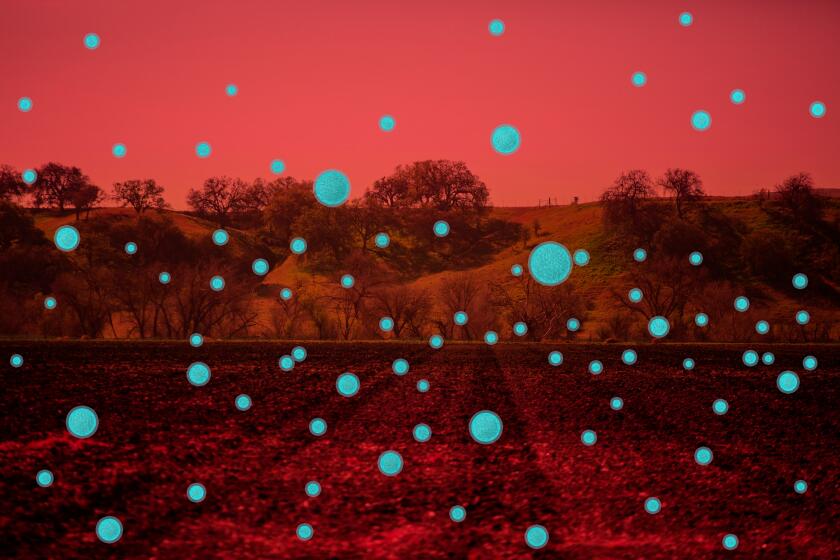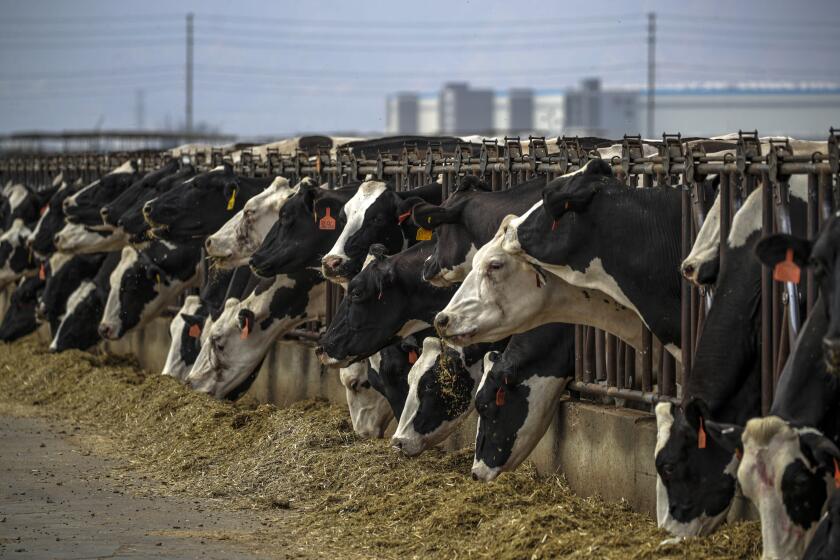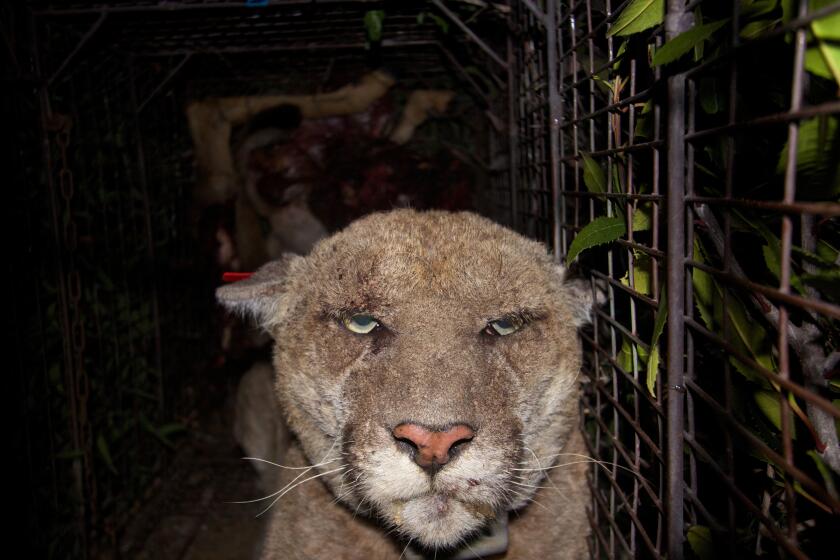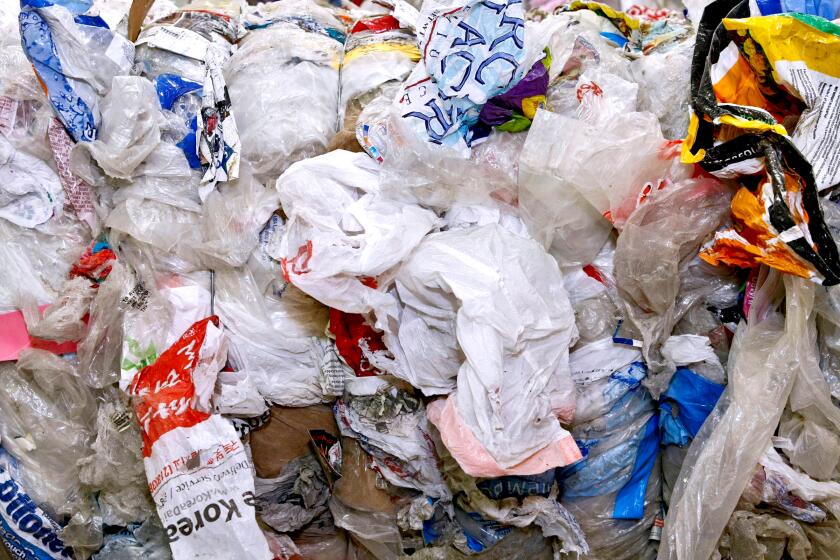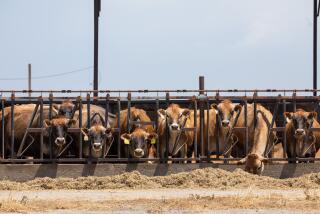
- Share via
As California struggles to contain an increasing number of H5N1 bird flu outbreaks at Central Valley dairy farms, veterinary experts and industry observers are voicing concern that the number of cattle deaths is far higher than anticipated.
Although dairy operators had been told to expect a mortality rate of less than 2%, preliminary reports suggest that 10% to 15% of infected cattle are dying, according to veterinarians and dairy farmers.
“I was shocked the first time I encountered it in one of my herds,” said Maxwell Beal, a Central Valley-based veterinarian who has been treating infected herds in California since late August. “It was just like, wow. Production-wise, this is a lot more serious than than we had hoped. And health-wise, it’s a lot more serious than we had been led to believe.”
As the range and incidence of valley fever grows, public health officials are struggling to warn visitors of the risk.
A total of 56 California dairy farms have reported bird flu outbreaks. At the same time, state health officials have reported two suspected cases of H5N1 infections among dairy workers in Tulare County, the largest dairy-producing county in the nation. With more than 600,000 dairy cows, the county accounts for roughly 30% of the state’s milk production.
Beal’s observations were confirmed by others during a Sept. 26 webinar for dairy farmers that was hosted by the California Dairy Quality Assurance Program — an arm of the industry-funded California Dairy Research Foundation. A summary of the findings and observations was reported in a newsletter published earlier this week by the program.
Beal, along with Murray Minnema, another Central Valley veterinarian, and Jason Lombard, a Colorado State University veterinarian, described their observations and data to dairy farmers to help them anticipate the signs of, and treatments for, the virus.
The webcast was not made available to The Times.
“The animals really don’t do well,” Beal told The Times.
He said the infected cows he has seen are not dissimilar to people who are suffering from a typical flu: “They don’t look so hot.”
He and others think the recent heat may be a factor.
State officials say two dairy workers in the Central Valley have contracted H5N1 bird flu. They say the risk of infection remains low for the general population.
Since the end of August, the Central Valley has suffered multiple heat waves, with daytime temperatures exceeding 100 degrees.
“Heat stress is always a problem in dairy cattle here in California,” he said. “So you take that, you add in this virus, which does have some affinity for the respiratory tract ... we always see a little bit of snotty noses and heavy breathing in animals that are affected ... and for some of them, just the stress takes them.”
Indeed, most of the deaths are not directly the result of the virus, he said, but are “virus adjacent.” For instance, he has seen a lot of bacterial pneumonia, which is likely the result of the cow’s depressed immune system, as well as bloat.
He said that when the cows aren’t feeling well, they often don’t eat.
“The digestive tract, or rumen, basically requires movement. There has to be things moving out of that rumen constantly in order for the pH balance and microbiome to stay where it should be,” he said. So, when they’re not eating, things in the digestive tract stagnate.
That, in turn, causes them to “asphyxiate because their diaphragm has too much pressure on it.”
In addition, he and others are seeing a lot of variation in the duration of illness.
Although early reports had suggested that the virus seemed mild and lasted only about a week or two, others are seeing it last several weeks. According to the industry newsletter, at one dairy, cows were shedding the virus 14 days before they showed clinical signs of illness. It then took three more weeks for the cows to get rid of the virus.
They’re also noticing the virus is affecting larger percentages of herds — in some cases, 50% to 60% of the animals. This is much more than the 10% that had been previously reported.
Some say the actual rate may be even higher.
“I would speculate infection is even higher; 50[% to] 60% are showing clinical signs due to heat stress or better herd monitoring earlier in infection. Unfortunately, few or no herds have been assessed retrospectively through serology testing to determine actual infection rates,” said John Korslund, a retired U.S. Department of Agriculture veterinarian epidemiologist.
Cows also are not returning to 100% production after they’ve cleared the virus, Beal said. Instead, he and others say it’s closer to 60% to 70%.
“There’s going to be some animals that are removed from the herd, because they never seem to come back,” he said.
Gov. Gavin Newsom has signed a bill that expands a moratorium on all types of a blood-thinning rat poison that has unintentionally sickened other animals.
Beal said his firsthand observations have challenged his notions about the disease, which has so often been described as mild and insignificant.
“Once I saw it myself, I said, this is something I need to communicate with my clients about. ... This is not something that is just a joke at the dinner table,” he said. “I didn’t want people to not take it seriously, because I see what it is doing to the animals, and it is rough to see — as an animal caretaker, as a veterinarian like myself — it’s just not something that’s enjoyable. It’s more serious than we had been led to believe.”
Beal said he is working hard with Central Valley farmers to treat the animals — largely by making sure the cattle are adequately hydrated. He also treats sick cows with a medication similar to aspirin to reduce fever, pain and discomfort.
He said the treatment is pretty effective and seems to be helping.
Others are not surprised H5N1 is becoming more severe in cows.
“As I’ve said since we first learned of the outbreak in dairy cows, nothing we’ve learned about this virus is new or unexpected,” said Rick Bright, a virologist and former head of the U.S. Biomedical Advanced Research and Development Authority. “It’s behaving exactly as we’ve come to know of this virus over the past 25 years. It’s spreading very efficiently now among mammals, and it’s mutating and adapting to mammals as it does.”
He credited state health officials and veterinarians for “being more forthcoming and transparent with their data” than other states, and said this may be the reason the virus seems to be hitting California cows so hard.
“This virus is out of control. It is time for urgent and serious leadership and action to halt further transmission and mutation,” Bright said. “The concept of letting it burn out through food animals, with unmonitored voluntary testing, has failed. There are pandemic playbooks that we need to dust off and begin to implement.”
In the meantime, officials continue to reassure the public about the safety of the nation’s dairy supply. They say pasteurization inactivates the virus. They also warn people to stay away from raw milk.
Beal noted that one of the sentinel signs that a farm has been infected is dead barn cats that have drunk the infected raw milk.
“It’s weird, actually, how consistently that seems to be happening everywhere,” he said. “It’s pretty sad and shocking. But that’s one of the first things that people see sometimes.”
Gov. Gavin Newsom signed into law a plastic bag bill that will ban stores from offering heavyweight “reusable” plastic bags at the checkout line.
There is also some suggestion that some cows that have recovered from the virus have been reinfected, although this has not been confirmed.
“We don’t have any data to support this yet, but there have been anecdotal reports of reinfections in herds,” said Kay Russo, a dairy-poultry vet with RSM Consulting, an international firm.
She said it could just be a persistent infection that is being observed, but also speculated that the virus could be mutating rapidly — and evolving “enough to reinfect an animal.”
And Jason Lombard, one of the speakers at the dairy webinar, said in an email that he had been told by veterinarians that they are observing clinical signs of disease in animals that had been infected, “but I don’t believe any of them have been confirmed via testing.”
As of Oct. 4, California officials have reported 56 infected herds. Although state officials will not disclose the location of these herds, the Valley Veterinarians Inc. website — a veterinary clinic run by large-animal vets in the Central Valley — said the infections are in Tulare and Fresno counties.
Steve Lyle, a California Department of Food and Agriculture spokesman, would not confirm the counties.
There are more than 200 herds in Tulare County and more than 100 in Fresno County. The state’s largest raw milk dairy is also in Fresno County.
Requests by The Times to observe infected farms or to speak with the owners of infected dairies went unanswered by the state and declined by industry insiders.
“We are not recommending farmers engage on this due to farm security issues we’ve had,” said Anja Raudabaugh, chief executive of Western United Dairies, an industry trade group for California dairy farmers. “It is very unwise to consider viewing a dairy under quarantine. ... This is just not the time.”
She said her organization doesn’t want anyone “doxing” farmers or increasing traffic at or near a farm, “both of which have happened.”
In the last week, the H5N1 virus has been detected in wastewater samples collected in Turlock, San Francisco, Sunnyvale and Palo Alto.
State epidemiologist Erica Pan said it was hard to know where the virus is coming from. Although Turlock is a dairy center, the detections in the San Francisco Bay Area cities could potentially be from wild birds, she said, but the source is unknown.
